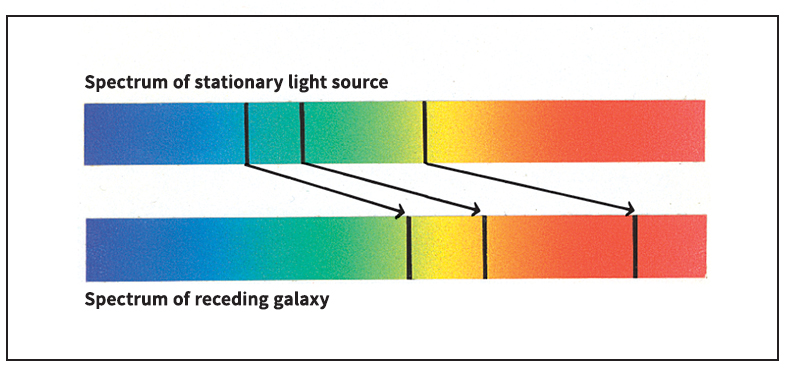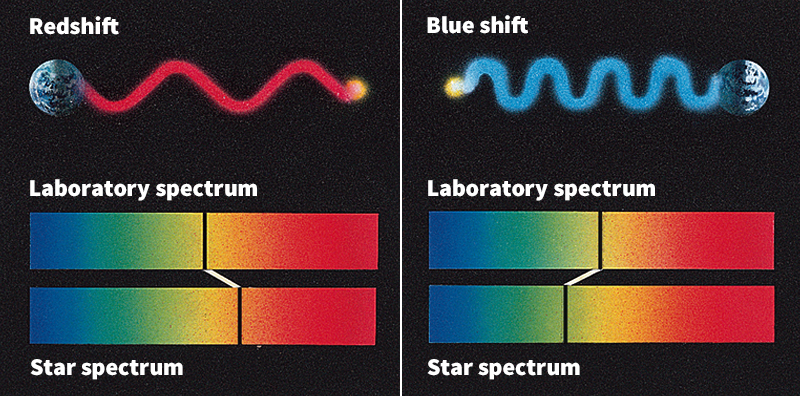Redshift is a stretching of the wavelengths of light or other electromagnetic waves, observed most often in radiation given off by astronomical objects. Wavelength is the distance between successive crests of a wave. Redshifts can occur in any type of electromagnetic wave, including radio waves, visible light, and X rays. Most observed redshifts result from two different causes. An object’s motion relative to the observer can produce a Doppler redshift. A cosmological redshift results from the expansion of space between the object and the observer. Astronomers often measure an object’s redshift to determine its speed or distance relative to Earth.

The Doppler redshift.
The motion of a wave source relative to an observer can cause a change in the wavelength of light, sound, or other waves given off by the object. Consider, for example, a train that whistles as it moves past an observer. As the train approaches, successive waves of sound from the whistle crowd together, resulting in a shorter wavelength and thus a higher observed pitch. As the train moves away, the waves spread out, and the listener hears a lower pitch. Scientists call this shifting in wavelength the Doppler effect.
Light waves given off by an object moving away from an observer will also spread out to longer wavelengths. The wavelength of a light wave determines its color, with red having the longest wavelength of visible light. The light will therefore appear redder, or redshifted, as a result of the object’s motion. Likewise, if the object is moving toward the observer, its light waves will crowd together and appear bluer, an effect known as blueshift.
Astronomers measure redshifts and blueshifts by arranging light from a cosmic source into a band of wavelengths called a spectrum. First, they examine the spectrum for characteristic wavelengths of light produced by specific atoms or molecules. They then compare these wavelengths to those given off by the same atoms or molecules on Earth. Such features may appear redshifted or blueshifted by an amount that depends on the speed and direction of the astronomical object’s motion. Scientists have observed many redshifted and blueshifted objects within our own galaxy, the Milky Way.
Cosmological redshift.
Astronomers have found that nearly all cosmic objects far outside the Milky Way have only redshifts—indicating that they are receding (becoming farther away) from our galaxy. In 1929, the American astronomer Edwin P. Hubble discovered this effect, which became known as the cosmological redshift. Hubble found that cosmic objects have redshifts in proportion to their distance from our galaxy, a principle called Hubble’s law. This law can be expressed by the equation v = H × d, where v is the redshift of the object expressed as a rate of recession, H is a fixed number known as the Hubble constant, and d is the object’s distance from Earth. Astronomers can use Hubble’s law to derive an object’s distance using its redshift. (See Hubble constant. )

The cosmological redshift does not result from the Doppler effect. Instead, it is produced by the expansion of the universe. Most scientists believe that the universe began expanding about 14 billion years ago in a cosmic explosion called the big bang. As the universe expands, the distance between most galaxies increases. The wavelength of light also steadily grows as it travels through the expanding space. The farther the radiation travels—that is, the more space it travels through—the more its wavelength stretches.
